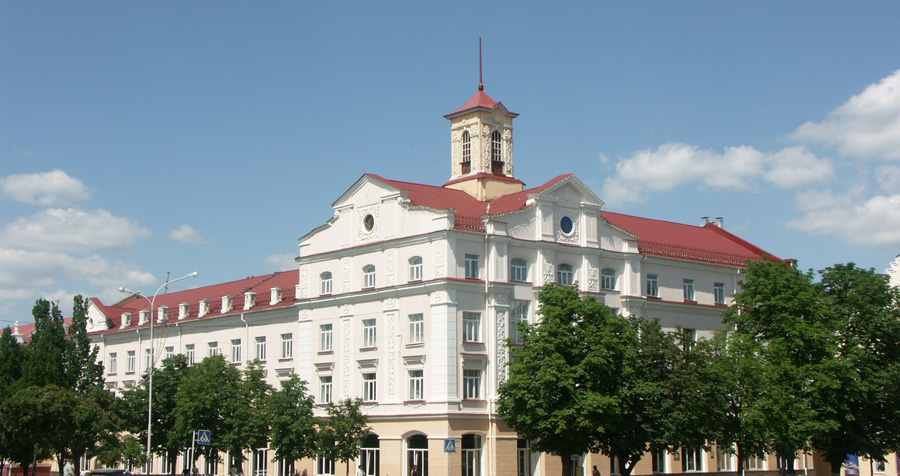
Red Square
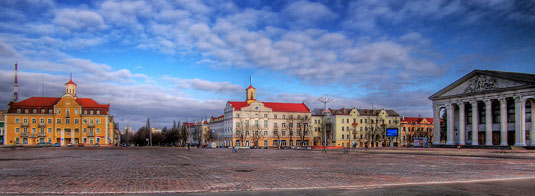
When at the turn of the 18th to the 19th centuries Chernihiv lost its importance as a fortress, its administrative center gradually shifted from the ancient territory of the Val (Dytynets) to the modern area of the Red Square. Before, this area was outside of the fortifications. This place was a trading place of the industrial Chernigov region. The square was called 'Pyatnitsky polye' or Friday Field, probably because of the adjacent Friday Church of St. Paraskeva, the patron of trade. In the early 19th century, the market was relocated to the Friday Field Square, in front of the fortress. At the same time, around the square (now by the name of Popudrenko Square) a city magistrate, a police department and a wooden theater were built, which gave the square a new name - Theatre Square.
On the square, stone shopping arcades were built (not preserved) and the area became known as the Red Marketplace. During the Soviet period the area was known as 'Kuibyshev'. During the Great Patriotic War, all the buildings were badly damaged or burned. A part of the buildings have been restored, rebuilt and new buildings were built. When in 1959 a new theater opened, named after Taras Shevchenko, the area took the appearance as it has today. Now, here is the regional administration (former provincial district council), the city council of the National Bank, the prosecutor's office and a cinema. siver.org.ua
Dytynets
Dytynets’ (Citadel or Kremlin) was the inner, reinforced part of the ancient cities of Kyiv Rus’. The name (probably) originated from the old rus’ expression meaning ‘being situated in the middle of the city’. It was a political-administrative center. The inner city is where the prince’s court and the garrison were situated and where boyars (nobles) and clergymen lived. Therefore the Dytynets’ was well fortified: earthwork rampart with walls, moats and so on. The rest of inhabitants: craftsmen, merchants and others lived in the so-called outer city.

The ancient Chernihiv Dytynets’ is situated on the headland in the interflow of the Desna and the Stryzhen’ rivers. Situated on the crossroads of main natural directions, it occupies a predominant position over the neighboring landscape. Such a position of the Dytynets’ provided the most favorable conditions for controlling and overviewing the surrounding areas. That’s why the territory of the Dytynets was the most convenient place for a settlement in ancient times. en.cult.gov.ua
Collegium
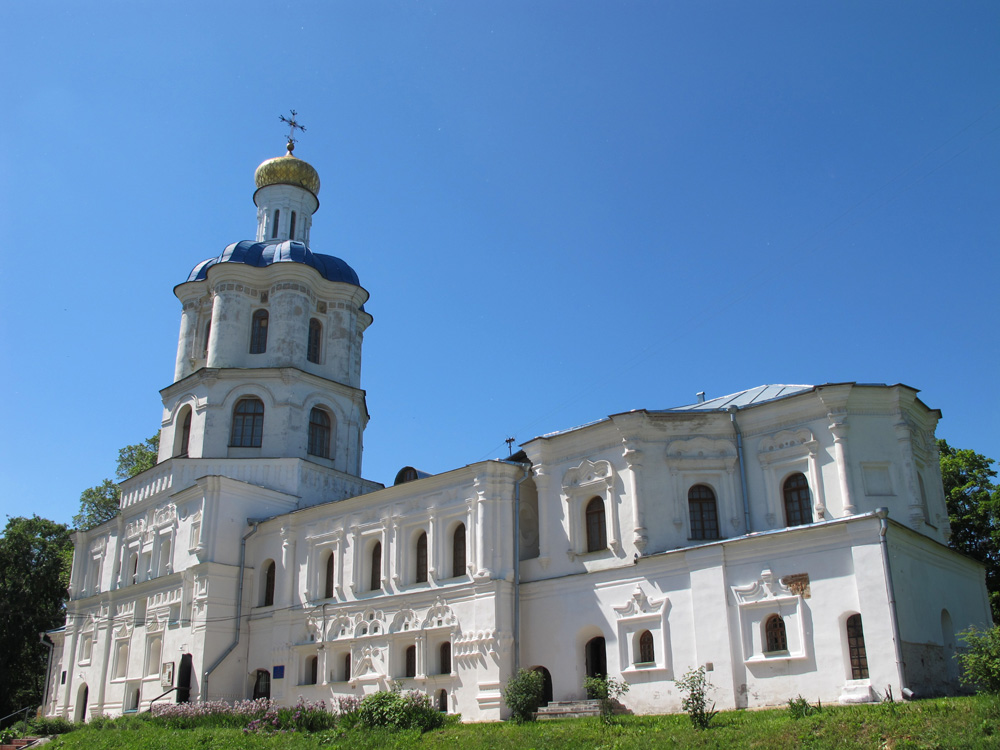
In the center of Chernihiv on the border of the former fortress rampart – the ancient historical center, now known as the Collegium, is situated. Once, this building was a part of the Borys and Hlib cathedral and monastery, the residence of the Chernihiv archbishops. It consists of a long two-storey building, a monastery refectory, and a bell-tower.
Archbishop Lazar Baranovych, who moved to Chernihiv in 1672, started to expand the cathedral. It is believed that building the refectory started on his initiative. In 1700 – 1702, Chernihiv archbishop Ioann Maksymovych, with encouragement and finances from hetman Ivan Mazepa, attached a bell-tower. Two domes of this church have not survived. The dome foundation board with Ivan Mazepa’s emblem and recording of his money offerings is exhibited here as evidence of the hetman’s patronage.
The church had one dome named after hetman patron St. John the Precurser. A well-known descriptor of the 18th century, Opanas Shafons’kyi, informed that while digging the foundations, a silver idol was found. Silver holy gates for the cathedral monastery were made of it. Hetman Ivan Mazepa’s emblem was also engraved on these gates.
The decoration of the building is close to the Russian style, especially of its south facade facing the Borys and Hlib monastery. The top of a dome is decorated with ceramic icons 'God’s Mother' and 'The Vernicle Image of the Saviour'.
Since 1749, classes of philosophy of the Chernihiv Collegium were held in the refectory, because of lack of space in the Borys and Hlib monastery. The Chernihiv Collegium is the first higher educational institution on Left-Bank Ukraine, that operated from 1700 until 1786.
The Collegium was founded after the example of the Kiev Mohyla Academy, which imitated principles of organization, tutorials of Western Europe universities and collegiums. Basic attention was paid to the study of Latin, less attention to the Church Slavonic language. Later they began to study Russian. People also studied Polish, Greek, German, French and Theory of poetry, Rhetoric, Philosophy, Mathematics, Geography etc. Collegium trained well-educated personnel for government service, interpreters, literary men, clerics and physicians.
Among the students of Chernihiv Collegium were some great names (about twenty known physicians of the XVIII century). For example, P.A. Zagorskyi - an academic and founder of the first school of anatomy in Russia). There was Y.T. Bilopol'skyi - chief doctor in O.V. Suvorov’s army, and F.I. Politkovskyi - professor of the Moscow University and prominent clinician.
In 1786, the Collegium was reorganized into a theological seminary. During the Second World War, the building was completely burnt. In 1954 – 1959 it was restored by Kyiv architect M.M. Hovdenko, also the architectural decor was renewed. Nowadays, the administration of the National architectural-historical park 'Chernihiv ancient' is located on these premises, displaying permanent exhibitions of Ukrainian icon-painting, devoted to the Chernihiv Collegium, and the exhibition 'Chernihiv and Chernihivites hundred years ago'. en.cult.gov.ua
Chorna mohyla (Black Grave) burial mound
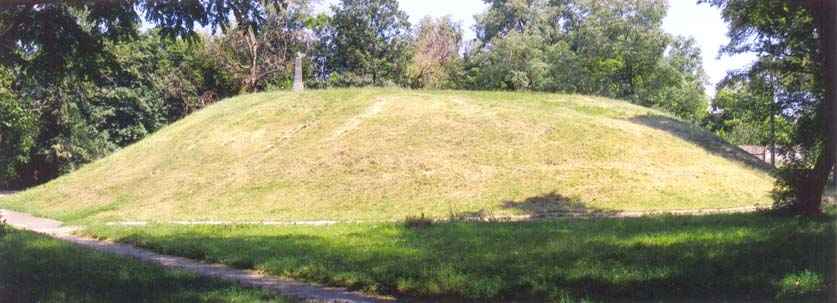
The majestic burial mound 'Chorna Mohyla' is located near the Yeletskyi monastery in Chernihiv. It is one of the biggest Old-Russian barrows of the 10th century, which still remains. Legend has it that here lies prince Chornyi, founder of the city naming it after himself. The size of the barrow is impressive: 40 m in the diameter, circumference is 125 m and present height is 11 m. In the past it was moated by a 7 m wide ditch. In 1872-1873, the mound was explored by native Chernihiv archeologist Dmytro Yakovych Samokvasov.
A man and a woman were buried in the mound according to the cremation ceremony: surrounded by belongings in the middle of the bonfire. The items are two swords, a sable, a spear, a saddle with stirrups, some shreds of hauberk, a helmet, arrowheads and a shield with copper bindings. These were laid at his feet. Also down by his feet two saddled horses lay. Also there was an iron vessel containing sheep bones and a bronze brazier with coals.
Among the items that belonged to the woman were ten sickles and twelve buckets, set in a semicircle in the western part of the bonfire, but only the iron bindings and two iron vessels remained. A lot of jewelry, belt tips, gold and silver ingots survived the cremation. A bronze vessel containing knucklebones, dice, keys, locks, axes and chisels were also found here.
The primary burial mound was 7 m high. After the cremation there was a funeral feast: a competition in honour of the deceased, after which the barrow poured over. Two richly ornamented drinking horns, made out of aurochs horns with silver bindings were found. The most interesting is the binding of the bigger horn with a marvelous frieze, whereon fabulous beasts, birds and people are depicted. In addition, two reaping knives and a bronze vanity of the Scandinavian god Thor were found at the funeral feast. These finds are considered as donations which satisfied the status of the deceased during his life. In the mound three Byzantine coins were uncovered, the oldest one was minted in 945-959 years by Kostyantyn the VII (Porphyrogenitus) and his son Vasyliy. According to this coin the mound is dated to 960s; prince Svyatoslav’s time.
Most of the Chorna Mohyla finds are kept at the Moscow historical museum. The part of exhibits, that was given to the Kyiv University museum and to some private collections by D. Samokvasov, was lost. en.cult.gov.ua
The Building of the Regimental Chancellery

It was built in 1690s on the territory of Dytynets (Citadel), not far from the castle ditch. Originally, it belonged to the Chernihiv colonel Yakiv Lyzohub, but after his death in 1698 it belonged to hetman Ivan Mazepa. In the 18th century, the Chancellery of Chernihiv Cossack Regiment was housed here. From the end of the 18th century until the 20th century, it was the archive. Nowadays, the funds of the Chernihiv historical museum by V. Tarnovskiy are kept in this building.
The size of the house according to the plan is 21 х 16 m. The house is a one-storey, six-compartment building, the type of ‘hut of two parts’. The two-compartment entrance hall divides the house into two parts: west for men and east for women, each having two rooms. The building has a gable roof with monumental triangular frontons on the side walls. The street entrance is on the north-east, facing the city square in the 17th century, and the back entrance is on the south-west and opens to the yard.
The Building of the Regimental Chancellery was damaged during the fires in 1718 and 1750. In the latter half of the 18th century the tambour, decorated with figured frontons, was added to the northern façade and one more small tambour was arranged as the entrance to the cellar from the yard. In one of the vaults the hatch to the attic was cut through. In the 19th century the ovens were destroyed, new windows were cut through in the eastern and western facades and the covering of the roof was changed to a tin covering. The house was restored in 1954 and 1969.
The Building of Regimental Chancellery is the most spectacular civil building of the 17th century in Left-bank Ukraine. It is the part of National architectural-historical Park 'Ancient Chernihiv'. en.cult.gov.ua
Manor of Glibov
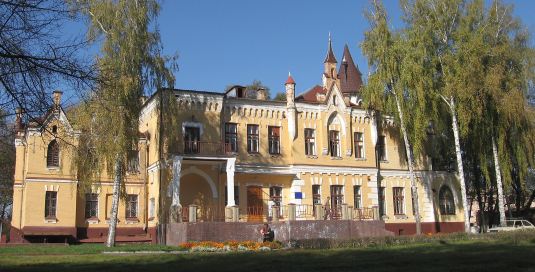
In ancient times, in the northern part of modern Chernihiv, above the Desna river, there was the fortified city of Gyurchev, mentioned in chronicles of 1152. Perhaps it is because of this, that at the end of the 19th century Glebov, the landowner, decided to build his mansion resembling a medieval (Western European) castle virtually on the spot of this ancient city. Coincidence or not, this mansion is one of the most original and beautiful buildings in Chernihiv. The farmstead consists of a few wooden and brick structures. The main building has a complex asymmetric layout that corresponds with Gothic architecture. Before the mansion is a square in the shape of a horseshoe. Near the house the gardener's house, the cartwright's house and the storehouse are preserved. Now, the Research Institute for Agricultural Microbiology is housed here. (siver.org.ua)
The Boldyn Hills
To the west of the historical center, the slopes of the Boldyn Hills rise. They are the highest in Chernihiv. The Boldyn Hills are on the right bank of the Desna river. The name of this area originates from the Old Russian word 'bold', which means 'oak'. For Slav-pagans the oak tree was considered a holy tree. In stories there are the Saint oak ravine and pagan temple, but archaeologists haven't found it (yet). A few oak trees still stand as witnesses of history. Today, they are between 200 to 400 years old. This place was mentioned in 1069, when Russ monk Anthony founded the Bohorodychnuy monastery: “Anthony loved the Boldyn Hills and settled here.”
In Old Russian pre-Christian times, the city burial mound cemetery was located here. In the territory of modern Chernihiv a lot of burial mounds remain, but the ones in Boldyn Hills are the largest. Besides, this burial mound necropolis is one of two that were saved within the city borders in Old Russ territory.
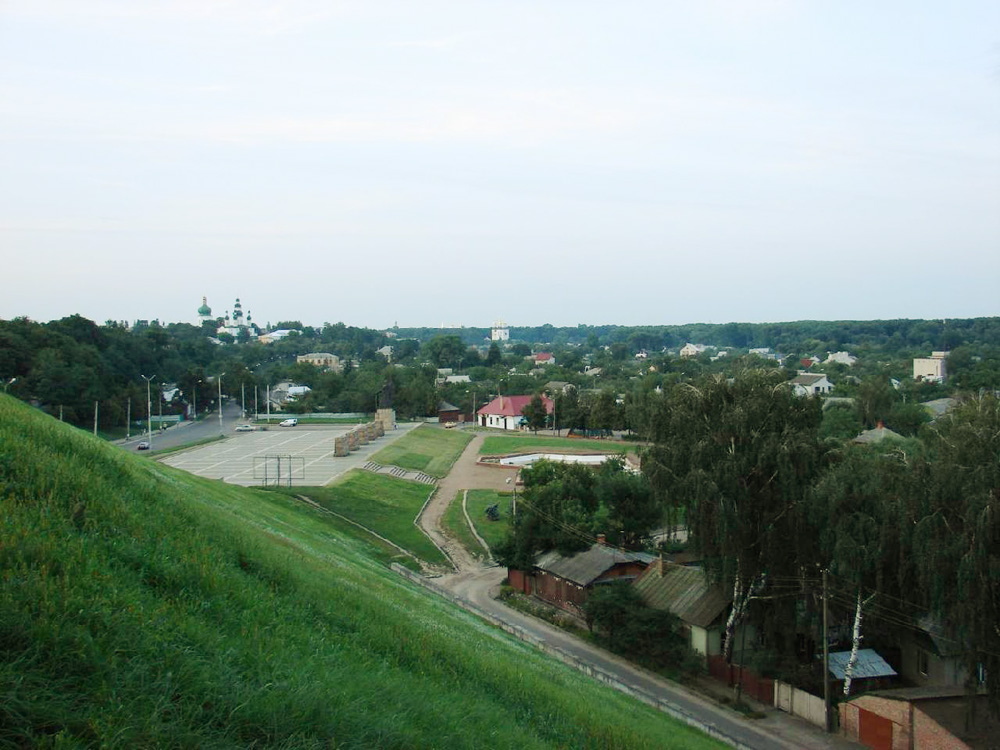
Until today, only the southern part of the necropolis remains, the northern part was built on in post-war years. Research of burial mounds was conducted in early 1970s by professor D. Samokvasov from Moscow. He numbered 232 burial mounds, 118 of them he dug out. Except differences in size, they also differ in burial ceremony. In all small burial mounds burials are done in grave pits. They are the burial places of simple people, almost all of them contained no items, only some decorations were found in 20 burial mounds (rings, beads). Two large burial mounds stand out: Hul’byshche and Bezimennyi. Here were buried princely men-at-arms. These burials were done according to the cremation ceremony.
Broadly speaking, the burial ceremony in large burial mounds is like the description of the Arabic traveller and writer from the 10th century, Ibn-Fadlana. At a burial site, first a small addition was done by making a coffin for the deceased wherein his belongings were put: tableware, meal, decorations, trappings and guns, if he was a warrior. The most beloved woman-concubine was also killed. Sometimes, women consented to be killed, not to be with an unloved person during the rest of their lives. The war-horse was killed. In presentation of Slavs the other world was similar to the real. Then the coffin was set on fire and all of it was burned. It was considered that the higher the smoke, the higher the place in heaven. When the fire burned out, a small burial mound was poured on which a funeral feast was made. Then a final burial mound was poured upon that. The higher social status of the person, the higher mound.
After researching 'Hul’byshche', this burial mound became well-known because of the big size of the weapons, that were found there. Among them was the biggest Old Russian sword, measuring 1.26 m. And so, Boldyn Hills became the traditional burial place for well-known people. Here is the grave of famous Ukrainian specialist in folklore and ethnographer O.V. Markovych. He was born in Poltava and was deported to Russia, to Orel city, for participating in the Kyrylo and Methodiy society. In Orel, he met his future wife, Maria Vilenska. After permission to return to Ukraine, he lived with his wife in Chernihiv. She began her literary career here.
A small ravine separates Markovych’s the grave from great Ukrainian writer M. Kotsiubynskyi’s grave. For fifteen years he lived in Chernigiv and wrote his best works here, such as ‘Fata Morgana’, in which he described the revolutionary events of 1905-1907. The writer died in 1913. He chose his burial site himself: his favourite resting place under an oak tree on top of the hill, where one has a magic view on the Desna river and on ancient Podil. Later, his wife V.U. Kotsubinska was buried near him.
At the edge of Boldyn Hill cape, alongside the burial sites of Slavonic warriors there is the grave of the Unknown Soldier, a warrior who gave his life in the Great Patriotic War. He was buried here on the Chernihiv’s highest place to commemorate all the warriors who were lost on the fronts of Great Patriotic War. The Eternal fire was lit in 1967.
But Boldyn Hills are not only a necropolis, it is a favorite resting place for residents and tourists. While walking here you will see an arbor. It was put here in 1911 in honour of His Emperor's Majesty tsar Mykola the II’s arrival to Chernigiv. A tea ceremony with a marvelous view was planned for him. But it didn’t happen and the arbor remained for descendants as a romantic place. Probably such was those visitors’ mood who named it 'Love arbor'. en.cult.gov.ua
BANDS AND SINGERS
Okean Elzy
Jamala
The Hardkiss
Tina Karol
Christina Solovy
Piccardysky Tertsiya
advertisement
Ruslana
Skryabin
Alyosha
Olexander Ponomarev
Zlata Ognevich
Onuka
advertisement
Antityla
Loboda
Irina Dumanskaya
Irina Fedishin
Vivienne Mort
Krykhitka Tsakhes
advertisement
S.K.A.Y.
Druha Rika
Boombox
Buv'ye
Lama
Platch Yeremy
advertisement
Voply Vidoplasova
T.N.M.K.
Tartak
Noomer 482
Braty Hadukyny
O. Torvald
advertisement
Bahroma
Epolets
Haidamaky
TIK
Ani Lorak






